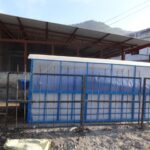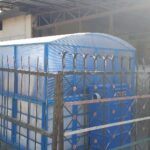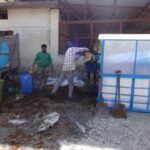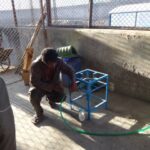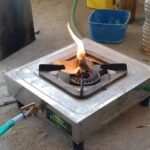BIO-METHANATION, BIOGAS AND BIO SLURRY GENERATION
BIO-METHANATION, BIOGAS AND BIO SLURRY GENERATION FROM FOOD WASTE AT PILGRIM DESTINATION OF SRINAGAR, GARHWAL BY INSTALLING IMPROVISED TUBULAR MODULAR BIO DIGESTER IN COLLABORATION WITH NAGAR PALIKA PARISHAD, SRINAGAR
INTRODUCTION AND BACKGROUND OF THE PROJECT
The project focuses on addressing the waste management issue in the tourist destination of Srinagar in Uttarakhand, which has experienced a significant increase in population and living standards in recent years. This increase has led to a corresponding rise in waste generation, resulting in pollution of land, water, and air. The use of fossil fuel energy for cooking and feeding tourists has also led to the production of large quantities of biodegradable and non-biodegradable waste, which is often disposed of openly along roadsides, in rock crevices, leading to the emission of greenhouse gases. The project aims to achieve four main objectives to address this problem. Firstly, it seeks to develop an efficient waste collection system that includes waste quantification and desiccation studies, identification of land, training and capacity building of waste collectors, and the integration of waste pickers into the system. Secondly, the project aims to promote source separation to generate resources and to create a closed loop in waste management that can be replicated in other destinations. Thirdly, the project seeks to link sweeping with the beat system to make the destination waste-free. Fourthly, the project aims to treat food and other biodegradable waste scientifically through Bio-methanation, which can generate bio-gas and bio-manure, both of which can be used to create a sustainable end-use disposal system.
To achieve these objectives, the project includes several components and activities, including preliminary studies on waste quantification and desiccation, identification of land for waste management, and procurement of necessary equipment. The project also involves training and capacity building for waste collectors, the integration of waste pickers into the system, and the development of a platform for the installation of a high rate modular digester. Additionally, the project seeks to create a social immersion innovation program that encourages entrepreneurship in waste management. The project aligns with the SWM rules 2000 and the Plastic Waste Management and Handling Rules 2011, aiming to achieve sustainable waste management through community participation in waste segregation and the payment of a user fee for the sustainable collection system. With the recycling of food waste into bio-gas and bio-manure and the integration of waste pickers into the system, the project aims to create a sustainable and replicable closed loop in waste management.
AIMS AND OBJECTIVES OF THE PROJECT
1. Establish a meticulously designed waste collection system, prioritizing both efficiency and effectiveness to ensure optimal waste management.
2. Advocate for the widespread adoption of source separation practices, strategically extracting valuable resources from the waste stream for further utilization.
3. Integrate a systematic beat system into the sweeping process, ensuring the thorough upkeep of destination areas by preventing waste accumulation.
4. Deploy cutting-edge bio-methanation processes to scientifically treat food and other biodegradable waste, optimizing their conversion into useful resources.
5. Incorporate waste pickers into the fabric of the waste management framework, acknowledging and leveraging their indispensable contributions to the overall system.
6. Cultivate an immersive innovation program that nurtures social engagement, fostering entrepreneurial initiatives within the dynamic realm of waste management.
7. Enforce a robust and comprehensive implementation of the Solid Waste Management Rules of 2000, meticulously adhering to the stipulated guidelines to ensure stringent compliance.
COMPONENTS AND ACTIVITIES OF THE PROJECT
1. Initiate an initial study encompassing waste quantification and assessment of desiccation processes.
2. Identify appropriate land parcels to serve as optimal locations for waste management facilities.
3. Offer comprehensive training and capacity-building initiatives tailored for waste collectors to enhance their skills.
4. Execute a streamlined waste segregation system at the source to ensure efficient sorting of waste materials.
5. Construct a dedicated platform primed for the installation of a high-rate modular digester for waste treatment.
6. Procure the requisite equipment essential for the smooth operation of waste management processes.
7. Collaborate closely with waste pickers to facilitate the effective handling and management of dry waste materials.
8. Establish a self-contained closed-loop waste management system, meticulously designed to serve as a replicable model for implementation in other geographical locations.
TARGET AREA OF THE PROJECT
The project is specifically focused on the Srinagar tourist route located in the Pauri Garhwal district of Uttarakhand, where a significant influx of tourists, particularly during the summer season, has resulted in an increased accumulation of waste in recent times.
TARGET GROUPS AND BENEFICIARIES OF THE PROJECT
The project’s beneficiaries include hotels, restaurants, and nearby communities residing in the vicinity of the bio-methanation plant that generates food waste, a pivotal element of the waste management system being established in the Srinagar tourist destination in Uttarakhand.
FUNDING PARTNER OF THE PROJECT
The G.B. Pant National Institute of Himalayan Environment (GBPNIHE), Ministry of Environment, Forest & Climate Change (MoEF&CC), Government of India, Kosi-Katarmal, District Almora, Uttarakhand, provided funding for the project.
SANCTIONED BUDGET OF THE PROJECT
The project received sanction from GBPNIHE in 2016 through the issuance of Sanction Order No. GBPI/IERP-NMHS/15-16/05/25 on 31.03.2016. The total budget sanctioned for the project was Rs. 14,74,000.00 for a duration of three years.
OUTCOMES AND ACHIEVEMENTS OF THE PROJECT
The following outcomes and achievements have been accomplished after the successful implementation of the Bio-Methanation, Biogas and Bio Slurry Generation Project:
1. An initial assessment has been conducted to quantify and efficiently manage waste, serving as the project’s foundational reference.
2. Comprehensive training and capacity-building initiatives have been administered to empower waste collectors, guaranteeing the efficacy of waste collection and proper disposal.
3. The adoption of a source segregation system has been successfully enacted, motivating households and businesses to segregate recyclable materials from non-recyclable waste at the point of generation.
4. Acquisition and subsequent installation of a bio-methanation plant have been meticulously undertaken to fortify the project’s resource infrastructure.
5. Waste pickers have been seamlessly integrated into the system, particularly in roles related to the handling and management of dry waste.
6. A self-sustaining waste management cycle has been established, showcasing a model that can be emulated in other locations.
7. The long-term viability and scalability of the waste management system have been strategically safeguarded to ensure its continued success and expansion.




